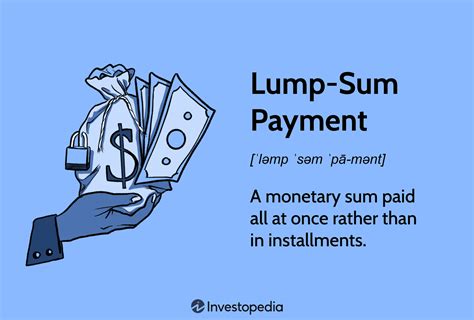
Weighing a one-time payment of $61,000 against monthly installments of $355 for life presents a complex financial dilemma, highlighting the critical need to consider factors such as age, health, inflation, and alternative investment opportunities.
The conundrum recently surfaced when an individual shared their job offer payout options on a Reddit forum, sparking a widespread debate on the optimal choice between a lump sum and lifetime payments. This decision, as highlighted by financial experts, is far from straightforward, demanding a comprehensive understanding of personal circumstances and long-term financial goals. The individual, facing this choice, sought advice, presenting a scenario that resonates with many navigating retirement plans, settlements, or other financial payouts. The core question revolves around whether immediate access to a substantial amount of capital outweighs the security of a guaranteed, consistent income stream for the remainder of one’s life.
Analyzing the Lump Sum
Opting for the $61,000 lump sum provides immediate financial flexibility. This capital can be used for various purposes, including debt repayment, investments, major purchases, or even seed money for entrepreneurial ventures. “The immediate access to capital allows for strategic deployment based on current needs and market conditions,” explains certified financial planner, Sarah Johnson. The ability to invest the lump sum is a key advantage. With prudent investment strategies, the $61,000 could potentially generate returns that significantly exceed the total value of the lifetime payments. However, this approach also carries risk. Investment returns are not guaranteed, and poor financial decisions could erode the principal.
One of the initial steps in evaluating the lump sum is determining the equivalent break-even point. In this scenario, it involves calculating how many months of $355 payments it would take to equal $61,000. Dividing $61,000 by $355 yields approximately 172 months, or 14.3 years. This means that if the individual expects to live longer than 14.3 years from the payout date, the lifetime payments would eventually surpass the value of the lump sum.
However, this simple calculation does not account for the time value of money. The time value of money posits that money available today is worth more than the same amount in the future due to its potential earning capacity. Factoring in inflation and potential investment returns, the lump sum becomes even more attractive.
To illustrate, consider a scenario where the $61,000 is invested and generates an average annual return of 5%. Over time, the investment could grow substantially. Using a compound interest calculator, assuming a 5% annual return and no further contributions, the $61,000 could grow to approximately $100,000 in about 10 years, and to over $162,000 in 20 years. This potential growth significantly outweighs the fixed $355 monthly payments.
However, it is crucial to acknowledge the inherent risks associated with investing. Market volatility, economic downturns, and poor investment choices can negatively impact returns and potentially diminish the value of the lump sum. Therefore, a conservative investment approach, such as diversifying across various asset classes, is essential to mitigate risk.
Moreover, the lump sum provides greater control over financial resources. The individual has the autonomy to decide how and when to spend the money, offering flexibility to adapt to changing circumstances. This control can be particularly valuable for individuals with specific financial goals or those who prefer to manage their own investments.
Evaluating Lifetime Payments
The primary advantage of lifetime payments is the guaranteed income stream, providing financial security and peace of mind. “Knowing that you will receive a consistent monthly payment, regardless of market conditions, can be incredibly reassuring, especially in retirement,” notes financial advisor, Mark Thompson. This stability is particularly appealing to individuals who are risk-averse or those who lack experience in managing investments.
The lifetime payments offer protection against longevity risk, the risk of outliving one’s savings. As life expectancies continue to increase, ensuring a steady income stream throughout retirement becomes increasingly important. The $355 monthly payments, while seemingly modest, can supplement other sources of income, such as Social Security or pensions, providing a more comfortable and secure financial future.
However, the fixed nature of the payments also presents a disadvantage. Inflation erodes the purchasing power of money over time. A fixed payment of $355 today will be worth less in real terms in 10 or 20 years due to rising prices. This is a significant consideration, especially for younger individuals who expect to live for many decades.
To account for inflation, one must consider the real rate of return, which is the nominal rate of return (in this case, the implied return from the payments) minus the inflation rate. If the inflation rate averages 3% per year, the real value of the $355 monthly payments will decline steadily over time.
Furthermore, the lifetime payments lack flexibility. The individual cannot access a larger sum of money for unexpected expenses or investment opportunities. This inflexibility can be a drawback, particularly for those who anticipate needing significant capital in the future.
Key Considerations and Influencing Factors
Several factors influence the optimal choice between a lump sum and lifetime payments:
-
Age and Health: Age is a critical factor. Younger individuals with a longer life expectancy are more likely to benefit from the lifetime payments, as they will receive the income stream for a longer period. However, they also have more time to potentially grow the lump sum through investments. Health is also a relevant consideration. Individuals with health issues may prefer the lump sum to cover medical expenses or other immediate needs.
-
Financial Situation: The individual’s current financial situation plays a crucial role. Those with significant debt may prefer the lump sum to pay off high-interest loans, freeing up cash flow. Individuals with limited savings may opt for the lifetime payments to ensure a steady income stream.
-
Risk Tolerance: Risk tolerance is a key determinant. Individuals who are comfortable with investing and managing their own finances may prefer the lump sum, while those who are risk-averse may opt for the security of the lifetime payments.
-
Investment Opportunities: The availability of attractive investment opportunities can influence the decision. If the individual has access to investments with high potential returns, the lump sum may be the more advantageous choice.
-
Inflation Expectations: Inflation expectations are crucial. If inflation is expected to remain low, the fixed payments may be more attractive. However, if inflation is expected to rise, the lump sum may be preferable, as it allows for investments that can potentially outpace inflation.
-
Tax Implications: The tax implications of each option must be carefully considered. Lump-sum payments are typically taxable in the year they are received, potentially pushing the individual into a higher tax bracket. Lifetime payments are also taxable, but the tax burden is spread out over time. Consulting with a tax advisor is essential to understand the specific tax consequences of each option.
-
Opportunity Cost: Opportunity cost refers to the potential benefits that are forfeited by choosing one option over another. By choosing the lump sum, the individual forgoes the guaranteed income stream of the lifetime payments. Conversely, by choosing the lifetime payments, the individual forgoes the potential investment returns of the lump sum.
Strategies for Making an Informed Decision
To make an informed decision, individuals should:
- Calculate the Break-Even Point: Determine how long it would take for the lifetime payments to equal the lump sum. This provides a baseline for evaluating the two options.
- Consider the Time Value of Money: Account for inflation and potential investment returns when comparing the lump sum and lifetime payments.
- Assess Risk Tolerance: Evaluate their comfort level with investing and managing their own finances.
- Evaluate Health and Longevity: Assess their health status and consider their life expectancy.
- Consult with a Financial Advisor: Seek professional guidance to analyze their specific financial situation and develop a personalized plan.
- Consider Tax Implications: Understand the tax consequences of each option and plan accordingly.
- Create a Budget: Outline current income and expenses to determine whether the lump sum investment potential is more suitable for the current financial situation or the monthly payments will better suit the current needs.
- Consider Alternative Investment Options: Research various options like stocks, bonds, mutual funds, ETFs, real estate, and other investments.
Real-World Examples and Case Studies
Several real-world examples illustrate the complexities of this decision:
- Retirement Planning: Many retirees face the choice between a lump-sum pension payout and monthly annuity payments. The decision often depends on their risk tolerance, investment knowledge, and life expectancy.
- Settlements: Individuals receiving settlements from lawsuits or insurance claims may have the option of a lump sum or structured payments. The choice depends on their immediate financial needs and long-term financial goals.
- Lottery Winnings: Lottery winners often face the dilemma of choosing between a lump sum and annuity payments. The decision can have significant tax and financial planning implications.
In one case study, a 60-year-old retiree was offered a lump-sum pension payout of $200,000 or monthly annuity payments of $1,200 for life. After consulting with a financial advisor, the retiree chose the lump sum and invested it in a diversified portfolio of stocks and bonds. Over the next 10 years, the portfolio generated an average annual return of 7%, significantly outperforming the annuity payments.
In another case study, a 40-year-old individual received a settlement of $100,000 and chose structured payments of $500 per month for 20 years. The individual was risk-averse and preferred the security of a guaranteed income stream. While the investment returns were lower than what could have been achieved with the lump sum, the individual valued the peace of mind that came with the guaranteed payments.
The Psychological Aspect of Financial Decisions
Financial decisions are often influenced by psychological factors. Loss aversion, the tendency to feel the pain of a loss more strongly than the pleasure of an equivalent gain, can play a significant role. Individuals may be more inclined to choose the guaranteed income stream of lifetime payments to avoid the risk of losing money with the lump sum.
Regret aversion, the desire to avoid future regret, can also influence the decision. Individuals may choose the option that they believe is less likely to lead to regret, even if it is not the most financially optimal choice.
Framing effects, the way in which information is presented, can also impact the decision. Presenting the lifetime payments as a “guaranteed income stream” may make them more appealing, while presenting the lump sum as an “opportunity to invest and grow your wealth” may make it more attractive.
The Role of Financial Literacy
Financial literacy, the ability to understand and effectively use financial skills, is crucial for making informed decisions about lump sums and lifetime payments. Individuals with a strong understanding of financial concepts such as compound interest, inflation, and risk management are better equipped to evaluate the two options and make a choice that aligns with their financial goals.
Financial literacy programs and resources can help individuals develop the knowledge and skills they need to make informed financial decisions. These programs can cover topics such as budgeting, saving, investing, and retirement planning.
The Future of Financial Payouts
The trend towards offering both lump-sum and lifetime payment options is likely to continue as individuals seek greater flexibility and control over their financial resources. As life expectancies increase and retirement planning becomes more complex, the need for informed financial decision-making will become even more critical.
Financial institutions and advisors will play an increasingly important role in helping individuals navigate these choices and develop personalized plans that meet their unique needs and circumstances. Technology will also play a role, with the development of new tools and platforms that provide individuals with access to financial information and advice.
Conclusion
The decision between a lump sum and lifetime payments is a personal one that depends on individual circumstances, financial goals, and risk tolerance. There is no one-size-fits-all answer. By carefully considering the factors discussed in this article and seeking professional guidance, individuals can make an informed decision that sets them on the path to financial security and peace of mind. The Reddit user’s scenario underscores the importance of thorough analysis and personalized financial planning when faced with such choices. Ultimately, the optimal choice is the one that best aligns with the individual’s unique needs and aspirations.
Frequently Asked Questions (FAQs)
-
What is the break-even point between the $61,000 lump sum and the $355 monthly payments, and what does it signify?
- The break-even point is approximately 172 months, or 14.3 years. This is calculated by dividing the lump sum ($61,000) by the monthly payment amount ($355). It signifies the point at which the total amount received from the monthly payments equals the lump sum. If the individual expects to live longer than 14.3 years after the payout, the lifetime payments would eventually exceed the lump sum’s value. However, this calculation doesn’t account for inflation or potential investment returns.
-
How does inflation impact the decision between a lump sum and lifetime payments, and how can it be factored into the analysis?
- Inflation erodes the purchasing power of money over time, meaning that a fixed payment of $355 will be worth less in real terms in the future. To account for inflation, consider the real rate of return, which is the nominal return (from the payments or potential investments) minus the inflation rate. If inflation is expected to be high, the lump sum might be more attractive, allowing for investments that could potentially outpace inflation. If inflation is expected to be low, the lifetime payments might retain more of their value.
-
What are some of the tax implications of choosing either the lump sum or the lifetime payments, and how can these be managed effectively?
- Lump-sum payments are typically taxable in the year they are received, potentially pushing the individual into a higher tax bracket. Lifetime payments are also taxable, but the tax burden is spread out over time. To manage these implications, consult with a tax advisor to understand the specific tax consequences of each option. Strategies might include tax-advantaged investments, spreading out the income over multiple years (if possible), or adjusting withholdings to avoid penalties.
-
What are the risks associated with investing the $61,000 lump sum, and how can these risks be mitigated?
- The risks associated with investing the lump sum include market volatility, economic downturns, and poor investment choices, which can negatively impact returns and potentially diminish the value of the principal. To mitigate these risks, diversify investments across various asset classes (stocks, bonds, real estate), consider a long-term investment horizon, and seek advice from a financial advisor to create a well-balanced portfolio. Avoid speculative or high-risk investments unless you have a high tolerance for risk and a thorough understanding of the potential downsides.
-
Besides age, health, and financial situation, what other less obvious factors should someone consider when deciding between a lump sum and lifetime payments?
- Less obvious factors include:
- Legacy planning: Do you want to leave a financial inheritance to heirs? The lump sum provides greater flexibility for estate planning.
- Desire for control: How important is it for you to have control over your finances and investment decisions? The lump sum offers more control.
- Potential for unexpected expenses: Do you anticipate needing a large sum of money for unforeseen expenses (medical bills, home repairs)? The lump sum provides immediate access to capital.
- Behavioral tendencies: Are you prone to overspending or making impulsive financial decisions? The lifetime payments offer a more structured and disciplined approach.
- Access to financial support: Do you have family or friends who can provide financial assistance if needed? This might influence your risk tolerance.
- Less obvious factors include:









